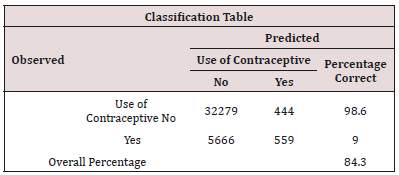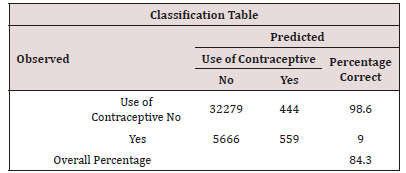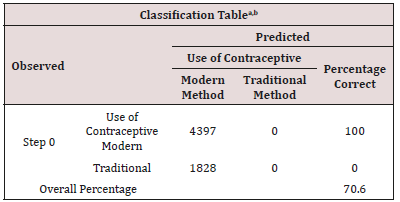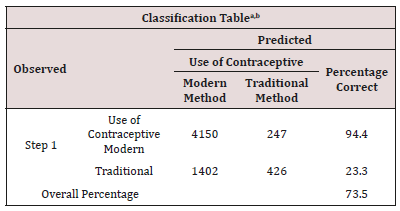
Lupine Publishers Group
Lupine Publishers
Menu
ISSN: 2644-1381
Research Article(ISSN: 2644-1381) 
Contraceptive Efficacy a Retrospective Analysis Among Nigerian Volume 1 - Issue 3
Afeez Mayowa Babalola1*, Maxwell OBUBU2, Oluwaseun A3 and OTEKUNRIN3
- 1 Department of statistics, university of Ilorin, Ilorin, Nigeria
- 2 Department of Statistics, Nnamdi Azikiwe University, Awka, Nigeria
- 3 Department of Statistics, University of Ibadan, Ibadan, Nigeria
Received: March 15, 2019; Published: March 25, 2019
*Corresponding author:Afeez Mayowa Babalola, Department of statistics, university of Ilorin, Ilorin, Nigeria
DOI: 10.32474/CTBB.2018.01.000113
Abstract
Background: This study examined contraceptive use patterns and method selection among women of reproductive age in Nigeria, with a particular focus on the extent to which demographic and socio - economic characteristics influenced contraceptive use practice. The Logistic models shows that women who know at least one method are more likely to use any contraceptive method than their non-method-knowing counterparts. Moreover, those women with more children ever born are more likely than their counterparts with fewer children ever born to use modern contraceptive methods. The probable reason for this may be that women with fewer children may still want more children and have the fear of side effects attributed to modern contraceptives.
Keywords: Logistic Regression; Contraceptive; Odds Ratio; Cox and Snell R-Square
Introduction
Contraception is one of reproductive health’s essential elements. It enables young people to determine the timing and number of their children and empowers them with respect and dignity to manage their lives. Productive health for adolescents is increasingly recognized as one of human development’s major determinants. Among the main development concerns regarding contraception or prevention of unwanted early pregnancies considered to have significant potential to improve the status. According to the World Bank, Nigeria’s annual population growth rate is late measured at 2.66 percent in 2014 and has been a major concern for population experts, statisticians, demographers and policy makers for a number of times. Nigeria’s relatively high birth rate, accompanied by steady death rate declines, has resulted in high population growth rates (Ebigbola and Ogunjuyigbe 1998), with an estimated doubling period of less than 25 years [1]. Unfortunately, this is nearly impossible to achieve as all available evidence shows that the economy’s growth rate was lower than the population’s growth rate. Living standards tend to deteriorate when population growth rates exceed economic growth rates (Feyisetan and Bamiwuye 1998). In Nigeria, there has been increased pressure for family limitations over the past four decades. This is due to the rapid growth of the big cities, the large expansion of educational facilities and the far greater difficulty in securing top jobs that have come with independence (Ebigbola and Ogunjuyigbe 1998). In line with the above-mentioned situation, the National Policy on Population for Development, Unity, Progress and Self-Reliance was formulated in 1988 and revised in 2004, the main goal of the policy is to reduce fertility rates by increasing contraception adoption (Federal Government of Nigeria 2004) [2].
Every year in Nigeria, an estimated 1.5 million unplanned pregnancies occur and about half of this results in an induced abortion. Nigeria is one of Sub-Saharan Africa’s highest maternal mortality ratios (MMR) and ranks as the country with the world’s second-highest maternal death rate. One third of Nigeria’s childbearing women had an unwanted pregnancy and one in ten had an induced abortion. Because abortion in Nigeria is legally only allowed to save the life of a woman, it is often performed under unsafe conditions with about a quarter resulting in serious complications. Such complications account for 20-40 percent of Nigeria’s approximately 60,000 maternal deaths annually. Young women make up a significant proportion of the country’s abortion seekers, and a recent review of women treated for complications of unsafe abortion in our community revealed that young unmarried people under the age of 25 are mostly affected [3-5].
Understanding the factors influencing contraceptive use is critical to program efforts to broaden contraceptive knowledge. Studies suggest that many potential users choose not to use more reliable methods because of misunderstandings and healthrelated risk concerns. A study, for example, found that family planning knowledge was universal, but only 30% of couples used a contraceptive method. A study on contraceptive use in Bangladesh and Indonesia shows that the current use of contraception as well as residence and number of living children are positively associated with female education. Women’s age is the last major variable that makes a positive contribution to contraceptive use (Ullah and Chakraborty, 1993). Women’s education also played a major role in contraceptive use in Pakistan, as literate women were more likely to use contraceptives than analphabets (Khan and Khan, 2007). The question then is why teenage pregnancy, maternal mortality ratio and premarital birth rise in Nigeria despite efforts by both private and public agencies m to provide friendly centers in public and private hospitals where contraceptive services could be accessed. This study is therefore intended to use data from the 2013 Demographic and Health Survey (NDHS) to study the knowledge of contraception and use of contraceptives among women in the six geopolitical zones in Nigeria [6-9].
Aims and Objectives
The purpose of this study is to examine the factors related to contraceptive use. To determine the data, a binary logistic regression analysis was performed
A. The probability of contraceptive use in relation to the respondent’s knowledge of contraceptive.
B. In this case, the relationship and strength between the independent variables include age, resident, number of living children, index of household wealth, level of education, religion, region and marital status.
C. The probability of contraceptive method in relation to certain socio-economic and demographic variables selected.
Significance of the Study
This study will have both theoretical and practical significance as it is aimed at addressing a society - wide fundamental issue.
A. This study will theoretically contribute to existing literature that will help women understand the extent and impact of ineffective contraceptive use.
B. In practice, the knowledge gained from this study is intended to raise public awareness of the importance and proper use of contraceptive methods.
Methodology
The Logistic Regression Equation
Logistic regression gives each predictor a coefficient “b” that measures its independent contribution to dependent variable variations, the dependent variable can only take one of the values0 or 1. What we want to predict, as in linear regression, from knowledge of relevant independent variables, but rather the probability (p) that it is 1 instead of 0. Furthermore, it is not possible to draw because logistic regression has only two values in the category or a straight line best fit (as in linear regression). Unfortunately, in order to normalize the distribution, a further mathematical transformation is needed. This log transformation to a log distribution of the (p) values allows us to create a link to the normal regression equation. Also known as the logit of or logit (p) is the log distribution (or logistic transformation of (π). Logit (p) is the log (to base e) of the ratio of odds or probability that the variable dependent is 1.
This is defined mathematically as:

Whereas ( ρ ) can only range from 0 to 1, logit (p) scale ranges from negative infinity to positive infinity.
The formula below shows the relationship between the usual regression equation (α+β1X1+β2X2+---)which is straight line formula, and the logistic regression equation. The form of the logistic regression equation is:

This just looks like a linear regression, and while logistical regression finds the best equation to fit, just as linear regression does, the principles on which it does so are quite different. It uses a maximum likelihood method instead of using a least-squared deviation criterion for the best fit, which maximizes the likelihood of obtaining the observed results given the fitted regression coefficients. As a result, the fitness and overall significance statistics used in logistic regression differ from those used in linear regression. The probability of success can be calculated with the following formula which is simply another rearrangement of the previous formula:

Also
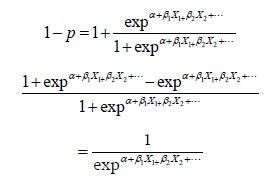
Therefore:
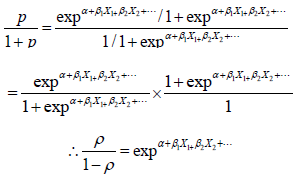
where:
ρ = Is the probability of success
exp= Is the exponential function
α = Is the constant of the equation
β = Is the coefficient of the predictor variables
Thus, logistic regression involves fitting an equation of the form to the data:

Explained Variables for the Study
In the first part of the analysis, the dependent variable was Contraceptive Use at the time of the survey. Contraceptive use was measured as a dichotomous variable (N0, Yes). In the first model, women who were practicing contraception at the time of the survey were coded 1 (Yes) and those who were not using any method were coded 0 (No) [10]. in the second part of the analysis, the dependent variable was contraceptive method use at the time of the survey, which examined the odds of choosing a modern method over a traditional method. Contraceptive Method was measured as a dichotomous variable (Modern method, Traditional Method). At the second analysis, respondents were reduced to 6,225 women who were current users at the time of the survey. Contraceptive methods defined as modern include pills, IUD (the intrauterine device), injectable, Implants, Sterilization, Condom, and LAM (Lactational Amenorrhea Method), while traditional methods include Periodic abstinence, withdrawal method, and folk methods. In the second model, women who were practicing modern contraception at the time of the survey were coded 1 (Modern) and those who were practicing traditional methods were coded 2 (Traditional) [11-13].
Explanatory Variables of the Study
The analysis used the same set of independent variables. Which is Age, Residence, Number of living children, Households wealth index, Educational level, Religion, Region, Marital status. The continuous variable for the woman’s age was replaced by three age groups: 15-29, 30-49, and 40-49, where 1, 2 and 3 represent the three age groups respectively. The place of residence used as categorized by the NDHS: Urban and Rural. The continuous variable for the number of living children was constructed with three groups: between 0 and 22 inclusive, three and four children and five and above children. Household’s wealth index was a discrete variable including five categories: Poorest, Poorer, Middle, Richer and Richest as categorized by the NDHS. Educational levels were grouped into four categories: No education, Primary, Secondary, and Higher also as classified by the NDHS. Religion had five which was later categorized into three categories: Christianity, Islam and other, where 1, 2 and 3 represent the three religion groups respectively. Regions were grouped into six geopolitical regions: North central, North East, North West, South East, South and South West. Marital status was sub-classified into four categories: Never in Union, Married, Widowed and Divorced, where 0, 1, 2, 3, and 4 represents the four marital status groups respectively [13-16].
Data Analysis and Presentation
Study Area
The data for this study is a secondary data obtain from the 2013 Nigeria Demographic and Health Survey (NDHS). The study was conducted in Nigeria under the support of the international Demographic and Health Survey (DHS) program. A cross-sectional household survey was conducted in Nigeria in which 38,948 households were sampled. In which 27,274 respondents were identified to be married and 9,820 were identified to be single [17] (Table 1.0).
Table 1.0: Summary of Frequency and Percentages of some Socio-economic and Demographic characteristics of Women in Nigeria.
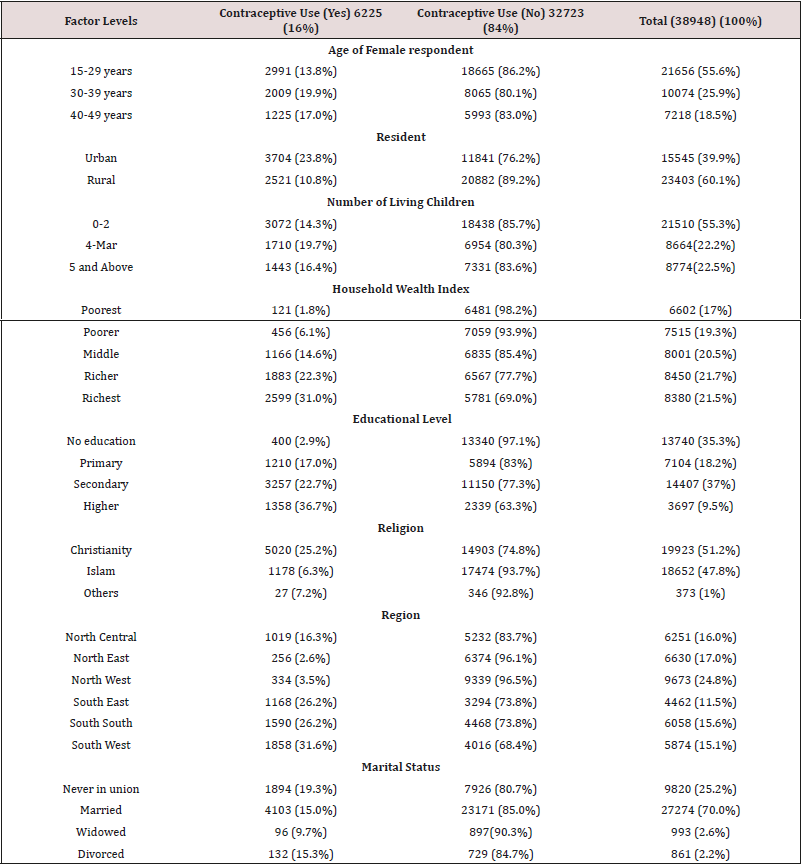
Interpretation of the odds ratio in Table 1.1 above
Table 1.1 describes the results of Logistic Regression analysis of predictors of contraceptive use. The logistic regression analysis shows that women age in Nigeria is a significant predictor of contraceptive used. In comparison with women aged from 15-29, 30-39 and 40- 49 years, it shows that women in 30-39 and 40-49 are more likely to use contraceptive more than those in 15-29. This finding may reflect an increasing need for contraception among the oldest group of women in Nigeria, this could be explained, perhaps, because they were older, they believed themselves to be no more in need of children. Rural women were slightly more likely to use contraception than their urban counterparts at the time of the survey. Women with 3-4 children were significantly less likely to use contraception than those who had two or less children. Interestingly, women with five children or more were less likely to practice contraception than women with two or less children; this result is surprising because the use of contraception usually increases with parity. This finding may reflect the relaxation/ ineffectiveness of the family planning programs. The household wealth index bore a negative relation to the use of contraceptive in Nigeria. Furthermore, women education has a significant effect in promoting a negative relationship with contraceptive use. More educated women were less likely to use contraceptive than those with no formal education at the time of the survey. Christian’s women were less likely to use contraception than women of other religions. However, this is not significant. Use of contraceptives was found to vary across marital status with Married women using the services most compared to other categories. In the study, Married women were found to be using contraceptives the most due to high incidences of sexual activities as couples compared to single women. In this case, it was revealed that use of contraceptives was aimed at helping to space children and prevent unwanted pregnancy.
Table 1.1: Odds ratios from Logistic regression analysis assessing the association between the Use of Contraceptive by some selected Demographic and Socio-economic characteristics of Women in Nigeria.
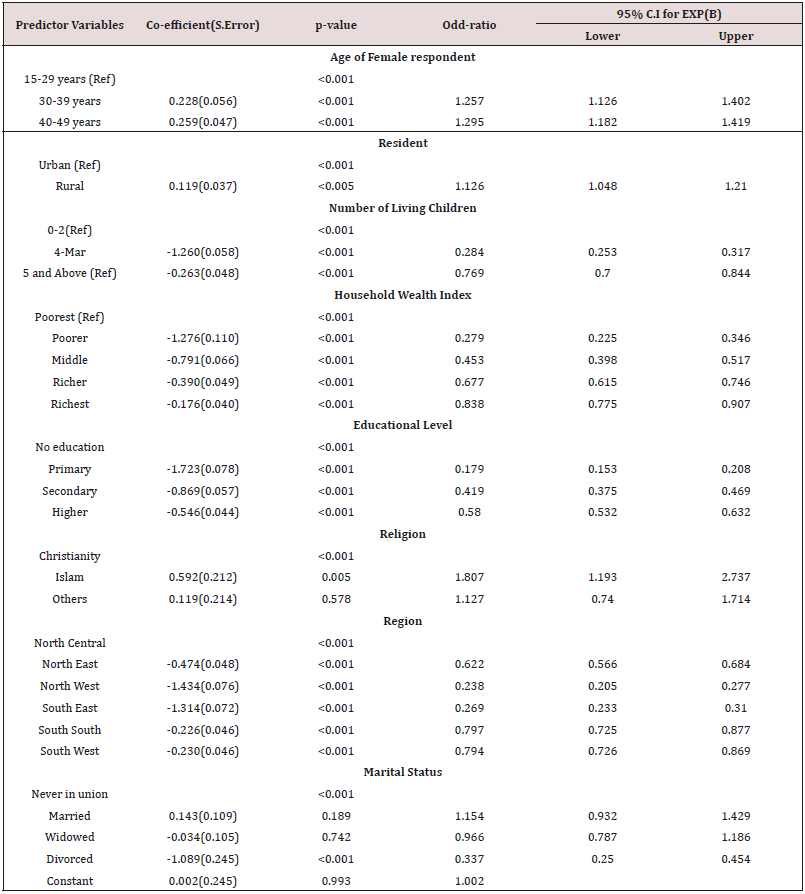
Block 0: Beginning Block
(Table 1.2) The Block 0 table above presents the results with only the constant included in the model. Logistic regression compares this model with a model including all the predictors (Age, Resident, Number of living children, Household wealth index, Education level, Religion and Marital status) to determine whether the latter model is more appropriate. The table suggests that if we knew nothing about our variable then the overall model predictive ability is 84%. For any significant variable when included would add to the predictive power of the model.
Block 1: Method = Enter
(Table 1.3) The Block 1 table above presents the results when the predictors “Age, Resident, Number of living children, Household wealth index, Education level, Religion and Marital status” enters the model. SPSS prints a classification table which shows that the classification error increased from 84% to 84.3% with the influence of the predictor’s variable.
Model Chi-Square
(Table 1.4) The Omnibus test of model coefficients compares the saturated model (the model with the entire predictors variable) to the null model (the model with only the contacts) which produces a chi-square value of 6666.247 with 22 degree of freedom (Table 1.5).
Model Summary
Cox and Snell R-Square attempts to imitate multiple R-square based on likelihood, it is indicating that 15.7% of the variation in the dependent variable which is explained by the logistic regression model. The Nagelkerke modification that does range from 0 to 1 is a more reliable measure of the relationship. Nagelkerke R-square will normally be higher than the Cox and Snell measures. It’s indicating a relationship of 26.9% between the predictors and the explained variable.
Interpretations of the Odd Ratios in the Table 2.0 above
Table 2.0: Odds ratios from Logistic regression analysis assessing the association between the Contraceptive Methods by some selected Demographic and Socio-economic characteristics of Women in Nigeria.
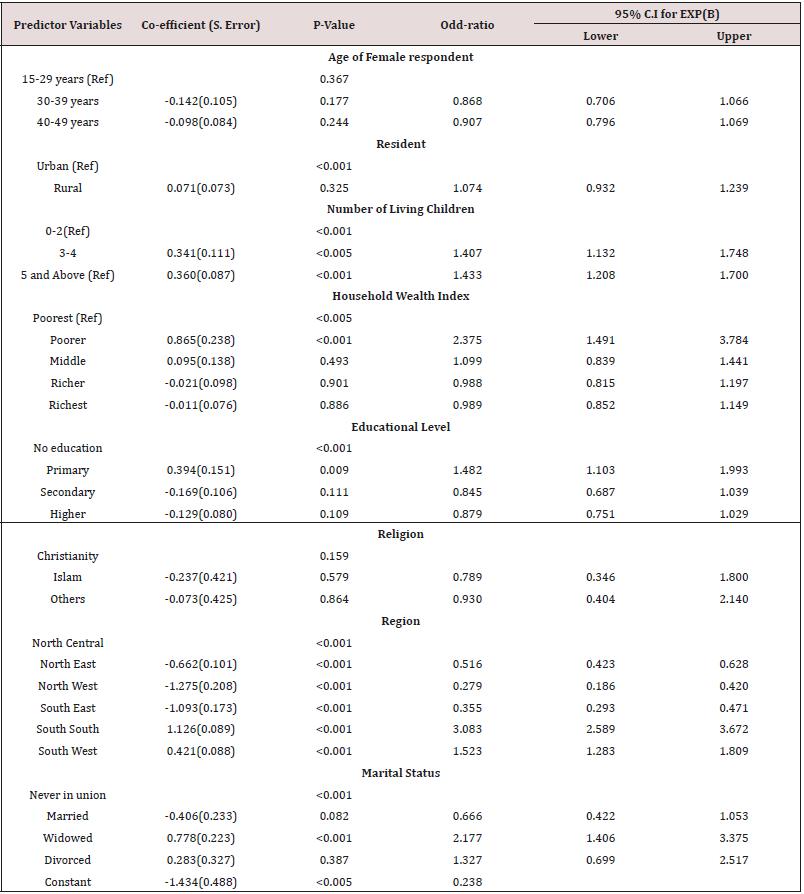
Table 2.0 describes the results of Logistic Regression analysis of preferred method of contraceptive among the respondent. The logistic regression analysis shows that women aged from 30-39 and 40-49 were less likely to use a traditional method compared to those who were aged 15-29. This finding may reflect an increasing need for modern contraception among the older age group of women, that is (older women are significantly more likely to use a long-term method than younger women). Rural women were slightly more likely to use traditional method than urban women, rural women were 7.4% more likely to use traditional methos contraception then their urban canter part. Women with 3-4 children and 5 & above children are significantly 40.7% and 43.3% respectively more likely to use traditional contraceptive method than those with 0-2 children. In comparison with women household wealth index, these findings show that the poorer women were twice more likely to use traditional method over the modern method, However the richer and richest categories of women are less likely to use a traditional method. This finding shows that the richer women have more access to modern contraceptive method than the less than average women. However, this is not statistically significant [18].
Women education is also an important variable which calls for attention when considering the method of contraceptive. Women with Primary education were said to be more likely to use traditional method over the modern contraceptive methods while the women with Secondary and Higher education were less likely to use traditional method over modern method. This shows that, the more educated women are more likely to have access and knowledge about the modern contraceptive methods then women with no formal education. At the time of the survey, the Muslims women were less likely to use the traditional contraceptive method over the modern method, however this was not significant.
Block 0: Beginning Block
(Table 2.1) The Block 0 table above presents the results with only the constant included in the model. Logistic regression compares this model with a model including all the predictors (Age, Resident, Number of living children, Household wealth index, Education level, Religion and Marital status) to determine whether the latter model is more appropriate. The table suggests that if we knew nothing about our variable then the overall model predictive ability is 70.6%. For any significant variable when included would add to the predictive power of the model.
(Table 2.2) The Block 1 table above presents the results when the predictors “Age, Resident, Number of living children, Household wealth index, Education level, Religion and Marital status” enters the model. SPSS prints a classification table which shows that the classification error increased from 70.6% to 73.5% with the influence of the predictor variables (Table 2.3).
Model Chi-square
The Omnibus test of model coefficients compares the saturated model (the model with the entire predictor variables) to the null model (the model with only the contacts) which produces a chisquare value of 647.230 with 22 degree of freedom (Table 2.4).
Table 2.4: Model Summary, a. Estimation terminated at iteration number 7 because parameter estimates changed by less than 0.001.

Model Summary
Cox and Snell R-Square attempts to imitate multiple R-square based on likelihood, it is indicating that 9.9% of the variation in the dependent variable which is explained by the logistic regression model. The Nagelkerke modification that does range from 0 to 1 is a more reliable measure of the relationship. Nagelkerke R-square will normally be higher than the Cox and Snell measures. It’s indicating a relationship of 14.1% between the predictors and the explained variable.
Summary
This study has examined the pattern of contraceptive use and choice of methods among women of reproductive age in Nigeria, with a particular focus on the extent to which demographic and socio-economic characteristics influenced the practice of contraceptive use. The results show that almost all characteristics such as age, resident, number of living children, household wealth index, education level, religion, region and marital status all have significant relationships with contraceptive use. All respondent was aware of contraceptive irrespective of the age at the time of the survey, however the high rate of awareness was not matched by the usage. This implies that knowledge about contraceptive does not translate to practice in the country. The disparity between awareness and usage is similar to reports from similar studies in Nigeria and are often attributed to poor organization of contraceptive services.
Results from the logistic models did not significantly support the hypotheses that women who know of at least one method are more likely to use any contraceptives method that their counterparts who know no method. Also, that those women with more children ever born are more likely to use Modern contraceptive methods than their counterparts with fewer children ever born. The likely reason for this may be because the women with fewer numbers of children might still want more children and having the fear of side effects attributed to Modern contraceptives [19]. Considering the regional zones, South and South west are more likely to use Modern contraceptive than every other regional zone. The might be as a result of high literacy rate among women in this region compare to other regions [20].
Conclusion
Evidence from the analysis, it can be concluded that a high level of sexual activity was not matched by the use of effective contraceptive among the respondent. This resulted in a high rate of unwanted pregnancy and reliance on induce abortion to prevent premarital births. Improving the educational and economic status of the women, educating them about modern contraceptive and planning programmes that will improve discussions at the family level on fertility-related issues will likely improve the level of use of modern contraceptives. The fear of side effects of steroid contraceptives was the main reason for non-use of the modern method, and this appeared to be geared by inaccurate and incomplete information’s mostly obtained from friends and siblings. Dedicated educational programmes on contraceptives through seminar, television shows, radio programs and school teachings will improve the knowledge and importance of contraception among women.
References
- Abiodun OM, Balogun OR (2009) Sexual activity and contraceptive use among young female students of tertiary educational institutions in Ilorin, Nigeria. Contraception 79(2): 146-149.
- AbouZahr C (2004) Maternal mortality: Helping mothers live, the reduction of maternal mortality ratios by three-quarters.
- Addai J (1999) Ethnicity and contraceptive use in sub-Saharan Africa: The case of Ghana. Journal of Bioscope Sciences 31: 105-120.
- Ahmed R (2006) Changes in contraceptive use and bnhj method mix in Pakistan: 1990 - 1991. Health Policy Plan 27(2): 166-174.
- Arowojolu AO, Adekunle AO (2000) Perception and practice of emergency contraception by post-secondary students in South West Nigeria; Afican jour Reproductive health 4(1): 156-165.
- Babalola AM, Obubu, George OA, Ikediuwa CU (2018) Retrospective Analysis of Some Factors Responsible for Infant Mortality in Nigeria: Evidence from Nigeria Demographic and Health Survey (NDHS). American Journal of Mathematics and Statistics 8(6): 184-189.
- Bankole A, Oye-Adeniran BA, Singh S (2006) Unwanted pregnancy and induced abortion in Nigeria causes and consequences.
- Bekele T (2005) Sexual behavior and its correlates, the case of young people in Adama. (M.Sc Thesis, University of Nazareth).
- Ezugwu EC, Onah HE, Ezugwu FO, Okafor II (2009). Maternal mortality in transitional hospital in Enugu south east Nigeria. African Journal of Health 13(4): 67-72.
- Germain A, Kyte R (1995) The Cairo consensus: The right agenda for the right time. International Women’s Health Coalition.
- Hajiya W (2008) Nigeria accounts for 10% global maternal mortality rate. Newsday Weekly.
- Kamara RM (1991) Sexual behavior and contraceptive use among secondary school teenagers in Kenya.
- Makinwa AP (1992) Sexual behavior: Reproductive knowledge and contraceptive use among urban Nigerians. International Family Planning Perspective 18: 67- 69.
- NPC & ICF Macro (2009) Nigeria demographic and health survey. Abuja, Nigeria: National Population Commission and ICF Macro.
- Odimegwu CO (2002) Emergency obstetric conditions, health seeking behavior and spousal Role in south west Nigeria: Mother’s perspectives.
- Obubu, M, Babalola AM, Ikediuwa CU, Amadi PE (2019) Parametric Survival Modeling of Maternal Obstetric Risk; a Censored Study. American Journal of Mathematics and Statistics, 9(1): 17-22.
- Okonofua FE, Abejide A, Makanjuola RA (1992) Maternal risk factor Ile-Ife, Nigeria: A study of risk factors. Study in family planning 23(15): 319-323.
- Pernoll ML (1994) Contraceptive choice among married women in Ghizhou province: Socio-cultural and relationship factors.
- WHO (2010) Accessing progress in Africa toward the millennium development goal. WHO report on MDG.
- Zlidar V (2003) New survey findings. The reproductive revolution continues. Population reports, Series m: Special Topics. Spring 17: 1-42.

Top Editors
-

Mark E Smith
Bio chemistry
University of Texas Medical Branch, USA -

Lawrence A Presley
Department of Criminal Justice
Liberty University, USA -

Thomas W Miller
Department of Psychiatry
University of Kentucky, USA -

Gjumrakch Aliev
Department of Medicine
Gally International Biomedical Research & Consulting LLC, USA -

Christopher Bryant
Department of Urbanisation and Agricultural
Montreal university, USA -

Robert William Frare
Oral & Maxillofacial Pathology
New York University, USA -

Rudolph Modesto Navari
Gastroenterology and Hepatology
University of Alabama, UK -

Andrew Hague
Department of Medicine
Universities of Bradford, UK -

George Gregory Buttigieg
Maltese College of Obstetrics and Gynaecology, Europe -

Chen-Hsiung Yeh
Oncology
Circulogene Theranostics, England -
.png)
Emilio Bucio-Carrillo
Radiation Chemistry
National University of Mexico, USA -
.jpg)
Casey J Grenier
Analytical Chemistry
Wentworth Institute of Technology, USA -
Hany Atalah
Minimally Invasive Surgery
Mercer University school of Medicine, USA -

Abu-Hussein Muhamad
Pediatric Dentistry
University of Athens , Greece

The annual scholar awards from Lupine Publishers honor a selected number Read More...




